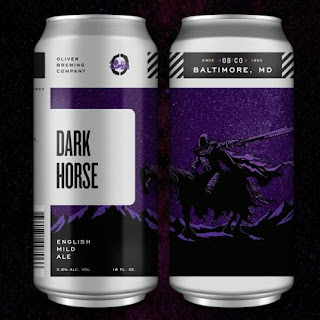"You must have seen great changes since you were a young man," said Winston tentatively. The old man's pale blue eyes moved from the darts board to the bar, and from the bar to the door of the Gents ... "The beer was better," he said finally. "And cheaper! When I was a young man, MILD beer —wallop we used to call it — was four-pence a pint. That was before the war, of course." "Which war was that? said Winston. "It's all wars,' said the old man vaguely. He took up his glass, and his shoulders straightened again. "Ere's wishing you the very best of 'ealth!"
**************
An open letter to Georgia brewers
Dear Georgia 'craft' brewers:As a recent Georgia immigrant (16 months and counting), I've enjoyed your beers: the sours, imperials, barrel-aged, and flavored.
Now, here's my challenge to you. In May, brew the opposite: brew...Mild Ale.
*************
Mild Ale is a Session Beer, quintessentially
Mild Ale It is not intemperate; it is not over-alcohol'd or over-hop'd; it is not spiced or soured. A Mild Ale is mild enough to disdain extreme flavors. Mild Ale is low enough in alcohol so that two (or more) can be enjoyed in sobriety. But it is more-ish: just flavorful enough that the triad of ale flavor —hops, yeast and, in particular, barley malt— are easily discerned, undisturbed by extraneous fruits and spices and flavorings.Dark? Maybe. Fruity? A tad. Hoppy? In the background but not timidly. A Mild Ale might be mild-mannered, but it does not lack sinew. Low calorie with gusto. It is the quintessential 'session' beer.
*************
Not just for Georgia brewers...
May is American Mild Ale Month
The month of May 2017 marks the third American Mild Month. Throughout the month, American breweries, nationwide, will be brewing Mild Ales and 'craft' beer pubs, serving them.
The whole thing is the idea of Alistair Reece —an ex-pat Scotsman, past Prague denizen, and, for several years now, a USA resident, who blogs at Fuggled.
In the United Kingdom, the Campaign for Real Ale (CAMRA) has been celebrating Mild Month in May for many years. * Mr. Reece asked, "why not here in the U.S.?" And, for three years now, we haven't had to ask.
*****************
What exactly is a Mild Ale?
Like porter before it, Mild Ale has been a disappearing beer in the U.K. And, here in the U.S., it's but a notch above nil.The name itself might be an impediment. Mild? What's that? Weak beer? A local brewer told me of the time, a decade ago, a Mild Ale was not selling well at his brewpub. He put the beer on the 'stout gas' line and renamed it "Nitro Monkey." It became a hit.
So, what exactly is a Mild Ale and what is an American Mild Ale?
▶ Session Beer
Start with the much-abused concept of 'session' beer. It does not mean simply brewing a lower-alcohol version of another beer. Beer and whisk(e)y writer Lew Bryson has defined American Session Ale as:
'Session,' therefore, is both 'sessionable' in alcohol and 'sessionable' in flavor. One and the other. Goldilocksian.- 4.5% alcohol by volume or less
- Flavorful enough to be interesting
- Balanced enough for multiple pints
- Conducive to conversation
- Reasonably priced
▶ Historical Milds
According to British beer historians Martyn Cornell and Ron Pattinson, milds of a hundred and more years ago tended to be sweet, but, then again, could also be highly hopped and/or very strong. The key was freshness.
Originally, the main, indeed the only standard for a beer called mild was that it should be fresh, not more than a couple of weeks old, and have the taste and aroma that come with freshness. Any older, past the point at which the beer starts exhibiting the flavours that come with maturity, and it isn't mild anymore, at least not what brewers would have recognized as mild back in the nineteenth and early twentieth centuries. [...]— Martyn Cornell. Amber, Gold & Black. 2010
All the other characteristics generally associated with mild today are secondary to the fact that it was meant to be delivered into the pub soon after it was brewed (just four to ten days after being casked [emphasis mine], against maturation periods of twenty-one days or more for the lighter draught pale ales).
The trend toward darker milds, as we know them today, began in the late 19th and early 20th centuries. The decrease in alcohol began in the early 20th century, and accelerated rapidly, for reasons such as tax laws and wartime restrictions.
▶ Modern Mild Ales
Today, the standard for Mild Ale might be as defined by the Campaign for Real Ale (CAMRA), in the U.K.
Milds are black to dark brown to pale amber in colour and come in a variety of styles from warming roasty ales to light refreshing lunchtime thirst quenchers. Malty and possibly sweet tones dominate the flavour profile but there may be a light hop flavour or aroma. Slight diacetyl (toffee/butterscotch) flavours are not inappropriate. Alcohol levels are typically low.
- Pale milds tend to have a lighter, more fruity aroma with gentle hoppiness.
- Dark milds may have a light roast malt or caramel character in aroma and taste.
- Scottish cask beers may have mild characteristics with a dominance of sweetness, smooth body and light bitterness.
Furthermore, British brewers have often used brewing sugars and other starches (such as flaked maize or flaked barley) to accompany the malted barley of a Mild Ale grist.- 4.5% alcohol by volume or less
****************
And so, now, we come to...
American Mild Ale, defined
No style disciplinarians need apply: brewers should have fun with this. But there are three lines not to cross. American Mild Ale is emphatically NOT a Session IPA. It is NOT spiced or soured. And American Mild does NOT contain alcohol greater than 4.5% by volume. Doing any of these, a brewer would be playing with 'session' semantics.
American Mild Ale, Mr. Reece suggests, should have an alcohol-content-by-volume (abv) of 4.5% or less, a color greater than 17 SRM (i.e., darker than a golden ale), and an International Bittering Unit (IBU) level of 30 or less (thus stronger than an English Mild, but 'milder' than an American IPA).
American Mild is not a hop bomb, but neither need it be a hop free zone. 'Low' is not the same as 'none;' it is all about restraint, and with the wide variety of American hops available the range of hop flavors is actually quite broad, whether its the spiciness of Cluster, the grapefruit of Amarillo, or the tropical fruit of El Dorado, there is room here for differentiation, and dry hopping is ok too.
Remember though, before going crazy with the hops, an American Mild is not a Session IPA, or a Session Cascadian Dark Ale, it's still a mild. Traditional English milds top out at 25 IBUs, but for an American Mild we would suggest an upper limit of 30 IBUs.
One major departure from the English mild style in a theoretical American mild is the yeast. The classic American yeast strain used by many an American craft brewery is known for being very clean, allowing the other ingredients to shine through without contributing the fruity flavors of the British yeasts.
*****************
Why should we celebrate Mild Ale?
You'll sometimes hear a brewer mention that a lager, such as pilsner or helles, is difficult to brew well because there's no place for the brewer to hide faults. In that, a Mild Ale is its ale counterpart.As Mr. Reece puts it, American Mild should be a "restrained, darkish ale, with gentle hopping and a clean finish so that the malt and what hops are present shine through." As Mr. Bryson puts it: it's "an unsung delicious beer style; tasty and 'more-ish' at low alcohol levels."
*****************
Mild and Cask
In the U.S., we often treat cask as only a special occasion thing, a one-off beer infused with extraneous gunk. And often with beer styles that are done a disservice by cask's lower carbonation and cellar temperature.
But ales like bitters and milds? On 'standard' tap, they can be wonderful. But they shine, shine, shine when presented in cask-conditioned form. Cask them, yes! Serve them uber-fresh, still living, gently bubbled without superfluous carbonation, drunk cool (NOT warm). Yes! But resist the temptation to disrespect them with cocoa-puffs or dingleberries. That is NOT Mild Ale.
***************
How to participate
- Sign Up
To join the fun in May, go to the sign up form. Pledge to brew a American Mild in May (cask-conditioned, a plus), and Mr. Reece will place your brewery's name and website on American Mild Month's web-roll of distinction. That's it! Brew a Mild, then package it or keg it or cask it, but serve it and tell America about it. - Brewpubs
This could be a simple matter for a brewpub that wished to participate, as well as for nano-breweries and other small production breweries. It might, however, be problematic for a larger production brewery. - Production Breweries
- ▶ In several states, production breweries are allowed to serve beer to patrons in their tasting rooms, like a bar, but without the food. That won't be the case here in Georgia until September, but a production brewery could produce a small batch on its pilot system, and serve it exclusively in its tap room?
- ▶ Or, produce a one-off 'collaboration' beer with another brewpub or brewery.
- ▶ Or, if a brewery already has a beer that fits (or comes close to) the parameters of American Mild, it could simply re-brand it for its taproom only and serve it there.
Oliver Brewing Company, in Baltimore, Maryland, brews a very British Dark Horse Mild. This May, it will be stamping the American Mild Month logo on the side of the cans.
- Pubs
Restaurant, pubs, and bars: want to play along? Ask your local breweries for Mild Ales in May. - Homebrewers
Organize competitions in May for American (and, okay, English-style) Mild Ales. Register those at the website. - Georgia (and American) good beer drinkers
You, the discerning drinker: you're the vanguard of offense and the bulwark of good taste. Tell your local breweries about this campaign for good session American Mild Ale. Ask your local pub to search for Mild Ales, and to serve them during May (if not year round).
*************
In Mild Conclusion
- Georgia 'craft' brewers:
According to Beer Guys Radio, there are sixty-five breweries and brewpubs in Georgia. Last year for American Mild Month, only Monday Night Brewery brewed a Mild Ale in Georgia, serving it in its taproom. This year, there are three:- I've had a Mild Ale at HopStix in Chamblee.
- Wrecking Bar in Little Five Points in Atlanta is brewing one.
- Twains Brewpub & Billiards brewed Mild Night.
The website is live at www.mildmonth.com; and so is Twitter at @MildMonthUS; and so is Facebook at AmericanMildMonth.
In his just published book "The Secrets of Master Brewers," Jeff Alworth succintly sums up the magic of Milds:
Whatever the formulation, milds are built to be drunk in bulk, to taste as pleasant on the first sip as the fourth pint, a trick that isn't as easy as it sounds.
This May, participate in American Mild Month. Please! Many of us wish to make a bulk session of it.
-----more-----









































